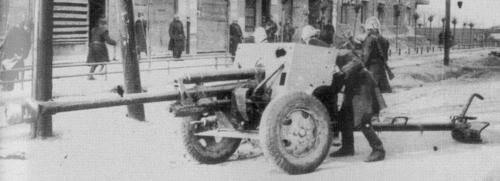
| Year | 1944 |
| Weapon Type | Medium Anti-Tank Gun |
| Origin & Designer | Romania/Resita |
| Numbers Produced | 342 |
| Crew | 7 |
| Calibre | 75mm |
| Elevation | -7° to +35° |
| Traverse | 70° |
| Breech | Vertical Sliding Block |
| Recoil | Hydropneumatic |
| Gun Sight | [@gun_sight] |
| Gun Mount | [@gun_mounts] |
| Carriage | Split Trail |
| Trailers | [@trailers] |
| Gun Shield | Two 6mm Plates |
| Armoured Plate | [@armoured_plate] |
| Barrel Length | 2.501mm (L/48) |
| Overall Length | 5.45m |
| Width | 1.82m |
| Height | 1.55m |
| Weight | Weight in Traction: 1.470 kg Weight in Action: 1.430 kg |
| Round Weight | 6.6 kg |
| Muzzle Velocity | 1.030 m/s |
| Feed | [@feed] |
| Magazine Capacity | [@magazine_capacity] |
| Practical Rate of Fire | [@practical_rate_of_fire] |
| Rate of Fire | 15-20 r.p.m. |
| Maximum Rate of Fire | [@maximum_rate_of_fire] |
| Maximum Ceiling | [@maximum_ceiling] |
| Maximum Ground Range | [@maximum_ground_range] |
| Maximum Range | 11.400m |
| Armour Penetration | 100mm @ 500m @ 30° |
| Traction | Motorised (RSO/1 Tractor) |
| Variants | [@variants] |
| Notes | After the first year of Operation Barbarossa, it became apparent to the Romanians that their anti-tank weapons were not effective enough against the Soviet T-34s and KV-1s, so the decision was made to up-grade to 75mm and work began in 1942 to design a new gun. The Resita model 1943 was a combination of two different weapons, the carriage and recoil was from the Soviet Zis-3 field gun and the barrel was from the Vickers model 31 anti-aircraft gun. It was chambered to fire same 75mm round that was used with German Pak 40 but had a slightly higher muzzle velocity. It was a powerful anti-tank gun which could easily defeat the T-34 and KV-1 plus it was also used as a light field piece. The first Romania units to receive these guns was the Romanian 1st armoured division, with others receiving theirs later. |